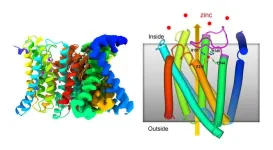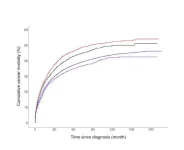(Press-News.org) Recently, a research team led by Prof. GOU Yanyu from the University of Science and Technology of China (USTC) of the Chinese Academy of Sciences (CAS) found that the solar outburst structure undergoes a complex reconfiguration evolution during the early outbursts, thus making important advances in the study of solar outburst activity. This study was published in Nature Astronomy.
In classical images, the core structure of a solar eruption is a magnetic rope consisted of spirally wound magnetic lines. When the eruption begins, the magnetic ropes around the core are transformed by magnetic reconnection into spirally wound magnetic lines, which wrap around the original core, leading to its rapid growth in a 'snowball' fashion. However, only a small fraction (only about a third) of the solar ejecta detected by various near-Earth and interplanetary spacecraft 'in situ' possessed the expected magnetic structure, while the rest deviated significantly from classical images.
By studying a coronal mass ejection event, the researchers revealed that the pre-emergence magnetic rope structure underwent a complex series of stripping, disintegration and reconstruction during the outburst. Observational evidence suggested that the pre-burst S-shaped magnetic rope structure developed from small-scale 'seeds'.
At the start of the outburst, the footpoints of the magnetic ropes are clearly outlined by a trapezoidal bright band in the lower atmosphere. During the subsequent violent outburst, the footpoints of the outburst structure are manifested as darkened regions in the corona due to the absence of material. With the highly dynamic changes in the solar chromospheric flare band and the consequent drift of the coronal darkening region, the footpoints of the eruptive structure shift dramatically, barely intersecting with the footpoints of the pre-eruptive magnetic rope. This is clearly in contrast with classical images, which predicted that the coronal darkening region characterizing the footpoints of the eruptive structure should have covered the footpoints of the original magnetic rope.
The end of the flare zone shows a highly irregular pattern and a back-and-forth sawing motion, revealing a complex three-dimensional magnetic reconnection within the magnetic rope and between the magnetic rope and the surrounding field. These phenomena suggested that the three-dimensional magnetic field reconnection during the eruption replaces the magnetic flux of the original magnetic rope almost completely.
This study reveals the details of the process of complex three-dimensional magnetic reconnection and its important role in the formation of coronal mass ejections. It provides a new physical explanation for the generation of complex ejection structures in interplanetary space, and sheds light on space weather forecasting.
END
USTC reveals reconfiguration process of solar eruptions
2023-06-09
ELSE PRESS RELEASES FROM THIS DATE:
DNA facilitates escape from metastability
2023-06-09
Prof. LIANG Haojun from the University of Science and Technology of China (USTC) of the Chinese Academy of Sciences (CAS) proposed a new method to escape from metastability for self-assembly in a far-from-equilibrium system. The study was published in PNAS.
Self-assembly refers to the process in which assembled primitive elements (molecules, nanoparticles, etc.) spontaneously form ordered structures through non-covalent interactions. Its excellent capacity to create new materials has drawn attention. In an ...
Single quantum bit achieves complex systems modeling
2023-06-09
A team led by Academician GUO Guangcan from the University of Science and Technology of China (USTC) of the Chinese Academy of Sciences (CAS), with collaborative efforts from the University of Manchester, and Nanyang Technological University, has achieved new progress in applying quantum technologies in complex systems modeling. The results were published in Nature Communications on May 6.
Stochastic modeling can help us to predict the future behavior of complex processes, which are non-Markovian. In order to simulate a non-Markovian process, a memory is of necessity to store a large amount of observed information about the past of the system. However, ...
Zinc transporter has built-in self-regulating sensor
2023-06-09
UPTON, NY — Scientists at the U.S. Department of Energy’s (DOE) Brookhaven National Laboratory have determined the atomic-level structure of a zinc-transporter protein, a molecular machine that regulates levels of this crucial trace metal micronutrient inside cells. As described in a paper just published in Nature Communications, the structure reveals how the cellular membrane protein shifts its shape to move zinc from the environment into a cell, and temporarily blocks this action automatically when zinc levels inside the cell get too high.
“Zinc is important for many biological ...
New model offers a way to speed up drug discovery
2023-06-09
CAMBRIDGE, MA — Huge libraries of drug compounds may hold potential treatments for a variety of diseases, such as cancer or heart disease. Ideally, scientists would like to experimentally test each of these compounds against all possible targets, but doing that kind of screen is prohibitively time-consuming.
In recent years, researchers have begun using computational methods to screen those libraries in hopes of speeding up drug discovery. However, many of those methods also take a long time, as most of them calculate each target protein’s ...
Black, Hispanic survivors of breast cancer have higher death rates from second cancers
2023-06-09
Hispanic and non-Hispanic Black female survivors of breast cancer experience higher death rates after being diagnosed with a second primary cancer than members of other ethnic and racial groups, according to recent research from investigators at the Johns Hopkins Kimmel Cancer Center.
In a study of nearly 40,000 adult survivors of breast cancer, the risk of death from a second cancer was 12% higher among non-Hispanic Black survivors and 8% higher among Hispanic survivors compared with non-Hispanic white survivors. Survivors in racial and ethnic minorities were diagnosed with second cancers ...
Mouse models of adolescent binge drinking reveal key long-lasting brain changes
2023-06-09
UNIVERSITY PARK, Pa — Heavy alcohol consumption may cause permanent dysregulation of neurons, or brain cells, in adolescents, according to a new study in mice. The findings suggest that exposure to binge-levels of alcohol during adolescence, when the brain is still developing, lead to long-lasting changes in the brain’s ability to signal and communicate — potentially setting the stage for long-term behavioral changes and hinting towards the mechanisms of alcohol-induced cognitive changes in humans.
“What we’re seeing here,” said Nikki Crowley, assistant professor in biology and biomedical engineering ...
Infants and toddlers up to 5 years old can participate in Shape Up! Keiki study at Pennington Biomedical
2023-06-09
The Pennington Biomedical Research Center is looking for children 5 years old and younger to participate in the Shape Up! Keiki research study. The purpose of the Shape Up! Keiki research study is to create a better way to measure and describe health from body shape.
“Parents can learn more about their child’s health by joining the Shape Up! Keiki study, while also providing important information that will help us find quick ways to measure obesity status and health based on a child’s body ...
Seenu Hariprasad named University of Chicago Chair of Ophthalmology and Visual Science
2023-06-09
Seenu M. Hariprasad, MD, the Shui-Chin Lee Professor of Ophthalmology, will be appointed Chair of the Department of Ophthalmology and Visual Science, effective July 1, 2023. He has been serving as Interim Chair since 2020.
Hariprasad is an internationally recognized vitreoretinal surgeon who originally joined the University of Chicago in 2005. Over the course of his career, he has developed a strong track record as a clinician, surgeon, researcher, educator, and leader in his department. He is a leading specialist in various vitreoretinal disorders, including macular degeneration, diabetic ...
Liquid metal sticks to surfaces without a binding agent
2023-06-09
Everyday materials such as paper and plastic could be transformed into electronic “smart devices” by using a simple new method to apply liquid metal to surfaces, according to scientists in Beijing, China. The study, published June 9 in the journal Cell Reports Physical Science, demonstrates a technique for applying a liquid metal coating to surfaces that do not easily bond with liquid metal. The approach is designed to work at a large scale and may have applications in wearable testing platforms, flexible devices, and soft robotics.
“Before, we thought that it was impossible for liquid metal ...
Estimated reductions in opioid overdose deaths with public health interventions
2023-06-09
About The Study: In this decision analytical model study of the opioid epidemic in four U.S. states, sustained implementation of interventions, including increased delivery of medications for opioid use disorder and naloxone supply, was found to be needed to reduce opioid-related overdose deaths and prevent deaths from increasing again.
Authors: Jagpreet Chhatwal, Ph.D., of Massachusetts General Hospital in Boston, is the corresponding author.
To access the embargoed study: Visit our For The Media website at this link https://media.jamanetwork.com/
(doi:10.1001/jamanetworkopen.2023.14925)
Editor’s Note: Please see ...





